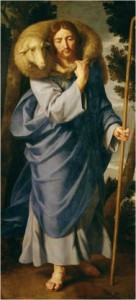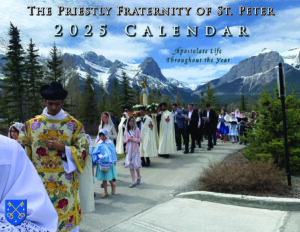The Parables of Christ: a Discussion of Fr. James Buckley, FSSP
 by Fr. James B. Buckley, FSSP
by Fr. James B. Buckley, FSSP
From the December 2010 Newsletter
When I was in the fifth grade at St. Luke’s in the South Bronx, Sister Vincentia one morning darkened all the classroom windows and turned off the electric lights. Standing in front of us, she held an orange in her left hand and a flashlight in her right. She shined the flashlight on the orange so that all of us could see that the upper part was in light and the lower part in darkness. She rotated the orange and what had been in light was now in darkness and what had been in darkness was now in light. By showing us the relationship between an orange and a lighted flashlight in a darkened room—something we could see—she taught us about something we could not see, i.e. the relationship between the sun and our planet earth.
In making known supernatural truths Christ also taught His audiences by comparisons with familiar things and He did this through parables. Parables belong to the literary category of a simile and not that of an allegory. In an allegory every detail of the literary figure corresponds to something outside of it. Saint Paul, for example, in his letter to the Ephesians uses allegory in describing the armor of the Christian in his fight against iniquity. He admonishes him to put on the “breastplate of justice,” take up “the shield of faith,” and wear the “helmet of salvation.” Each of those three pieces of armament signify three distinct spiritual realities, i.e. justice, faith and salvation. Unlike an allegory, a simile has one point of comparison. Matthew 10:16, for examples, says: “Behold, I send you as sheep in the midst of wolves.” Christ here compares the apostles to sheep because like the sheep they are weak and defenseless.
The parable is in the category of a simile because it provides a point of comparison between unlike things. It differs from a simple simile—according to commentators —because it teaches moral and dogmatic truths about the Kingdom of God. Secondly, because the parable does so by presenting an image in concrete detail, commentators further agree, that the parable is more elaborate than a simple simile.
In his Parables of the Kingdom, the Protestant commentator C.H. Dodd writes, “there is a reason for this realism in the parables of Jesus. It arises from a conviction that there is no mere analogy, but an inward affinity, between the natural order and the supernatural order, or as we might put it in the language of the parables themselves, the Kingdom of God is intrinsically like the processes of nature and of the daily life of man.” The Catholic commentator Leopold Fonck, S.J. makes the same point when in his Parables of the Gospel he writes: “That such images and comparisons for the illustration of the supernatural order exist everywhere in the natural world is in accordance with the relation which the divine creator willed should exist between the visible and the invisible world.”
A striking example of the visible world illustrating the invisible world is found in Our Lord’s explanation of the parable of the Sower. Just as the productiveness or non-productiveness of the seed depends upon the soil that receives it, so does the productiveness or non-productiveness of the word of God depend upon the receptiveness of those who hear it. This basic comparison is further subdivided. Just as the seed does not penetrate the footpath, the word of God does not penetrate the hearts of the calloused and indifferent. As the seed which flourished for a time in rocky ground and among thorns ultimately yielded no fruit, so it is with those who welcome the word of God but afterwards fall away. Some do so because they are unwilling to make the necessary sacrifices (the rocky ground) and others because they do not curb their inordinate desires (the thorns). The seed which bears fruit does not do so to the same degree and this re-emphasizes the point that the productiveness of God’s word depends on the receptiveness of those who hear it.
Because Christ did not explain all of his parables, Catholic exegetes have alerted us to clues of interpretation. Before touching on any of these, however, a difficulty regarding the object of the parables arising from Mark 4:11–12 (and parallel passages in Matthew 13:13 and Luke 8:10) must be confronted. There Christ says: “To you it is given to know the mystery of the kingdom of God: but to them that are without, all things are done in parables: That seeing they may not see, and not perceive; and hearing they may hear, and not understand; lest at any time they should be converted, and their sins should be forgiven them.”
December 5, 2010








